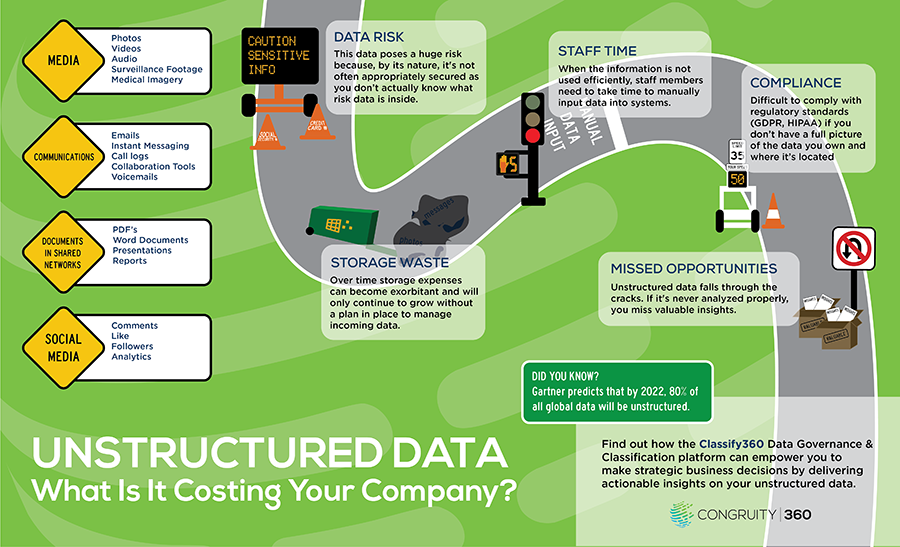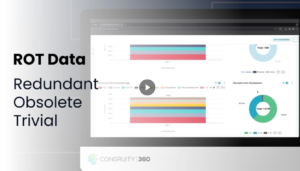Unstructured data, as you might guess, is any type of data that can’t be easily organized into your typical database or spreadsheet. These are the pieces of content that you come across every day. They exist in emails and social media. You might run across this information in webinars or conference calls. Your call centers get unstructured data in the form of verbal communications. Unstructured data grows at an exponential rate and the statistics are eye-popping — 91% of companies report that poor data wastes revenue and about 88% of data is ignored.
While technology keeps moving to develop automated ways to collect, store, and analyze these types of information, there is still a wealth of unstructured data that your company could benefit from. Not addressing this unstructured data costs you in missed opportunities, staff-hours, security risks, and storage space.
What data is unstructured?
Structured data lives in databases, like your CRM. It can be easily imported into reports and used in a myriad of ways to impact business decisions, provide insights, and oversee your revenue cycle.
Unstructured data is all the information that falls outside these structured databases. It’s not easily moved into a structure or report, so it’s not used effectively. In fact, one Forbes article from 2019 is routinely cited in terms of unstructured data. They said that 95% of businesses have a need to manage their unstructured data and 40% of those companies said they need to manage their unstructured data frequently. Some estimates indicate that unstructured data is growing at up to 65% each year, with Gartner predicting that by 2022 80% of all global data will be unstructured.
You know where your structured data resides, but you might not be aware of all the ways you house and use unstructured data. Here are a few places that unstructured data exists in most organizations:
- Media. If you’re using or sharing video or images, this is unstructured data. Some industries have a great deal of imagery that needs to be organized, for instance, medical images that go with patient files or surveillance video footage. Or consider other user-created or shared images and videos that do not have business value that are taking up storage space.
- Email. Some information in email correspondence may be housed in your CRM or other databases, but the actual content of the email correspondence is unstructured. Often email contains highly sensitive company information, which makes this a more complex problem. How many emails do you send out per day? Multiply that by every member of your team and then add all the incoming correspondence. It accounts for a huge amount of data that may not be used efficiently or stored in an advantageous way.
- Documents in Shared Networks. Your company may have any number of created documents, such as proposals, bids, reports, presentations, and files that are created through various programs and shared among staff members. These documents live outside your database. Common documents of this nature might include PDF, Image Files, and Word documents.
- Social Media Exchanges. If you run any social networks, there’s a wealth of data attached to your engagement, social media mentions, and communications on each platform that your marketing department uses. But not all of it is housed in a structured way. The analytics doesn’t include exact communications because it can’t be easily categorized into a database.
- Call Logs/Verbal Conversations/Call Center Recordings. Different vendors are working toward AI solutions to develop a structure for this information but conversations are still largely unstructured data. The best way to navigate verbal communications in terms of data is to transcribe the audio and manually use the data to collect insights, which is time-consuming.
- Open-Ended Survey Responses. Survey responses are often housed in your database, but open-ended survey responses don’t produce measurable analytics because the answers are necessarily unique to the participant. These can be an excellent source of customer insight, but they do need to be manually interpreted.
How does unstructured data cost your company?
There are several issues that are compounding as companies continue to generate a wealth of unstructured data without an adequate system in place to manage this information.
Here are some key areas that your company should be concerned with:
- Data Risk. Data security is a major issue for every company. We’ve all seen the explosion of cybersecurity breaches in the last few years. Your unstructured data poses a huge risk because, by its nature, it’s not often appropriately secured as you don’t actually know what risk data is inside. Consider the information that might be housed in an employee’s email or files. Your unstructured data might include sensitive customer information, employee information, and corporate intellectual property.
- Storage Waste. Those files take up space on servers and in physical locations. That space costs money monthly. Over time that expense can become exorbitant and it will only continue to grow without a plan in place to manage incoming data.
- Staff Time. This is a large cost of unstructured data. When the information is not used efficiently, staff members need to take time to manually input data into systems. In many cases, we see multiple staff members working with the same data repeatedly because it’s never recorded in a central database. There are also issues of employee error whenever there is a manual manipulation of data.
- Missed Opportunities and Poor Customer Experience. Unstructured data falls through the cracks. If it’s never analyzed properly, you miss valuable insights. This can mean missed opportunities to move with the trending market and meet your target customer’s needs. In a more granular way, missing these bits of information can mean that the customer needs to communicate with multiple staff members before resolving issues or satisfactorily completing their process with your company.
- Compliance. Unstructured data poses a large problem for regulatory compliance – for both privacy regulations like GDPR and CCPA along with industry regulations like HIPAA. You can’t know for certain that you’re effectively complying with the regulatory standards that govern your business if you don’t have a full picture of the data you own and where it’s located.
Addressing your unstructured data and understanding what’s inside that data needs to be a top business priority in order to mitigate risk, achieve compliance, make strategic storage decisions, and leverage valuable business intelligence. The key takeaway here is that this isn’t an issue that will go away – unstructured data continues to grow daily. Finding methods to manage, store, and analyze this wealth of information will be essential for enterprises. It may seem like a mammoth job, but cleaning up the unstructured data of the past is the first step in paving the way for a better-organized future.
Are you looking to gain insights into what’s inside your unstructured data so you can make strategic business decisions? Contact Team360 today to see a demo of how Classify360 can deliver actionable insights into your unstructured data.








